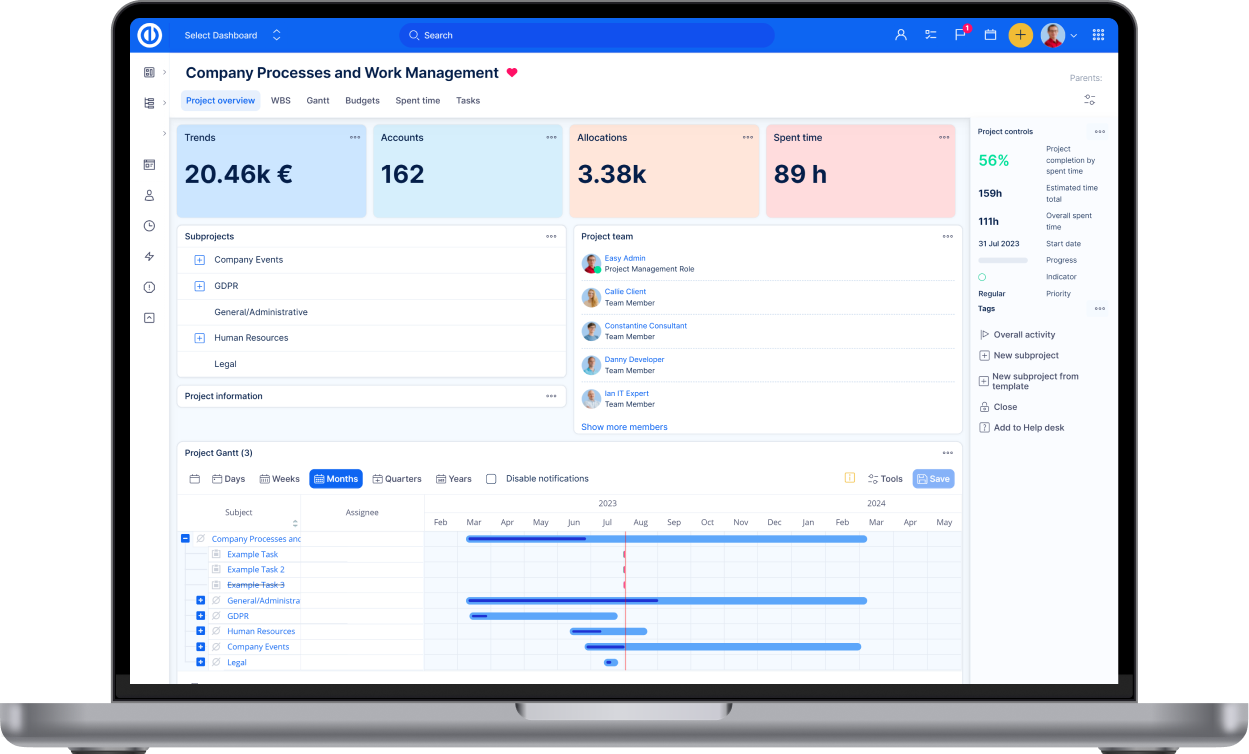Knowledge base alternatives: Is Confluence the best choice for you?
An internal knowledge base improves efficiency, communication, and collaboration in companies. Its importance has grown with the rise of Agile methodologies. Atlassian's Confluence is the market leader in central knowledge management, but there are some alternatives that outperform it in certain areas.

Table of contents
Looking for an open-source alternative to Confluence?
Limitations of Confluence for knowledge management
Staying on Confluence Server puts your projects at risk
BlueSpice: Confluence’s agile alternative with semantic search
Knowledge Base of Easy Redmine
Confluence vs. Knowledge Base
Confluence and Knowledge Base comparison: Conclusion
TL;DR
Confluence is no longer the only option—Easy Redmine’s Knowledge Base offers a more flexible, secure, and AI-powered alternative for modern knowledge management.
Looking for an open-source alternative to Confluence?
For those who prioritise open-source solutions, Confluence is not the best choice. If you are unsure of how to handle Confluence's structure with its various spaces, you may be better served by considering an alternative.
Take a closer look at the Knowledge Base supported by BlueSpice, which is integrated into Easy Redmine, and compare both systems!
Limitations of Confluence for knowledge management
Confluence is widely used for knowledge management, with spaces offering clear structure and permissions. Yet, building a logical page hierarchy remains manual and time-consuming, especially with its drag-and-drop setup.
While the rights system helps protect sensitive content, it often limits cross-space collaboration. If users lack access to both spaces, they may not see relevant content—hurting knowledge sharing.
Access rights also affect search results. If a user can’t access a page, it’s excluded from results—even if it’s relevant. Its built-in search supports keywords and filters, but lacks semantic search, which may hinder users looking for deeper or contextual results.
Also, Confluence users report several drawbacks:
- the cloud version offers fewer features than the server edition
- Confluence Cloud is having slower performance
- higher long-term cost
- too complex interface
- limited customisation
- reduced control under Atlassian’s SaaS model
Staying on Confluence Server puts your projects at risk
The end of support for Atlassian Confluence Server on February 15, 2024, affects users in several significant ways:
- No technical support: Atlassian and Marketplace partners no longer provide technical support for Confluence Server. Users encountering issues or bugs will have to troubleshoot and resolve problems themselves without official assistance.
- No security updates or bug fixes: There will be no more security patches or bug fixes, leaving server instances vulnerable to security threats, data breaches, and cyberattacks.
- Compliance risks: Running unsupported software can lead to non-compliance with industry standards and regulations, potentially resulting in legal penalties or reputational damage.
- Limited scalability and flexibility: Server versions will not receive feature upgrades, limiting the ability to scale or adapt to changing business needs.
- Performance and reliability decline: Lack of updates can cause the server to become less reliable and performant over time, risking downtime and business disruptions.
- App and marketplace limitations: No new licenses or Marketplace apps can be purchased for the Server version, restricting customisation and extension possibilities.
Organisations should plan to migrate to Atlassian Cloud or Data Center editions where ongoing support, security, updates, and scalability continue to be offered. Remaining on the server post-end-of-support poses increasing operational and security risks.
BlueSpice: Confluence’s agile alternative with semantic search
BlueSpice is an enterprise wiki built on MediaWiki, the open-source platform behind Wikipedia. Developed by Hallo Welt! GmbH, it turns MediaWiki into a robust knowledge management system for agile environments and is integrated within Easy Redmine as Knowledge Base.
It maintains MediaWiki’s core structure but adds hierarchy through categories and subpages. Its standout feature is semantic search, powered by the SemanticData extension, which enables fast and precise information retrieval—especially in technology-focused wikis.
BlueSpice is compliant with modern security standards and offers flexible user management. It integrates with LDAP or AD, or users can manage access independently through an intuitive interface.

Knowledge Base of Easy Redmine
Knowledge Base of Easy Redmine, on the other hand, builds on the Wikipedia approach—knowledge should be as accessible and quickly findable as possible. All knowledge is therefore organised much more “centrally” and captured with a fast and precise search engine.
In addition, there are the most important functions for fast and systematic editing, quality assurance, mapping complex content, and much more. And, of course, extra rooms for teams and projects can be set up with Name spaces, in specific cases, a dedicated Knowledge Base instance.
And now you power your Knowledge Base with Knowledge Assistant that brings AI directly into your daily work, helping teams find information faster and make better decisions. From quick answers to context-aware insights, it turns your company knowledge into an accessible, reliable resource for everyone.

Confluence vs. Knowledge Base
The following comparison makes clear that Knowledge Base, with its feature set and integration to Easy Redmine, is a serious alternative. This compact product doesn’t require add-ons purchases and thus brings clear and predictable values and cost of ownership.
The table below provides the main comparisons between Confluence and Knowledge Base:
|
Knowledge Base |
Confluence |
|
|---|---|---|
| Purpose | Organises documentation, processes, manuals, and quality management and maintains knowledge within the whole organisation. | For sharing knowledge with only a selection of coworkers. |
| Use cases |
- Knowledgebase - IT documentation - Technical documentation - Intranet - QA, manuals, and process descriptions - Process documentation - Support and customer service documentation - Quality management - Organisation manuals and how-tos - Integrated management system |
- Knowledgebase - IT documentation - Technical documentation - Intranet |
| Technology | MediaWiki (PHP, JavaScript) | Java |
| Open source | ||
| Server licenses (On-premises) |
||
| Cloud licences | ||
| License for distributed architectures (high performance) |
BlueSpice farm subscription | Datacenter license |
| Other ways of technical provisioning |
- Docker - Virtual Machine |
- Docker |
| Expandability | Various MediaWiki extensions | Accessible plugins via App Store |
| Localization | Over 25 languages supported | 25 standard languages |
| Customisations and services | Professional and personal support | Support via external partners |
Confluence and Knowledge Base comparison: Conclusion
As Atlassian Confluence phases out its Server version and shifts to a more restrictive Cloud model, many organisations are reconsidering their knowledge management tools. Confluence’s limitations—such as reduced control, complex rights management, and lack of semantic search—can hinder effective collaboration.
Easy Redmine’s Knowledge Base, powered by BlueSpice, offers a modern alternative with fast search, open-source flexibility, and AI support for daily work.
Try Easy Redmine Knowledge Base and see how it helps teams find, share, and manage knowledge more efficiently!



